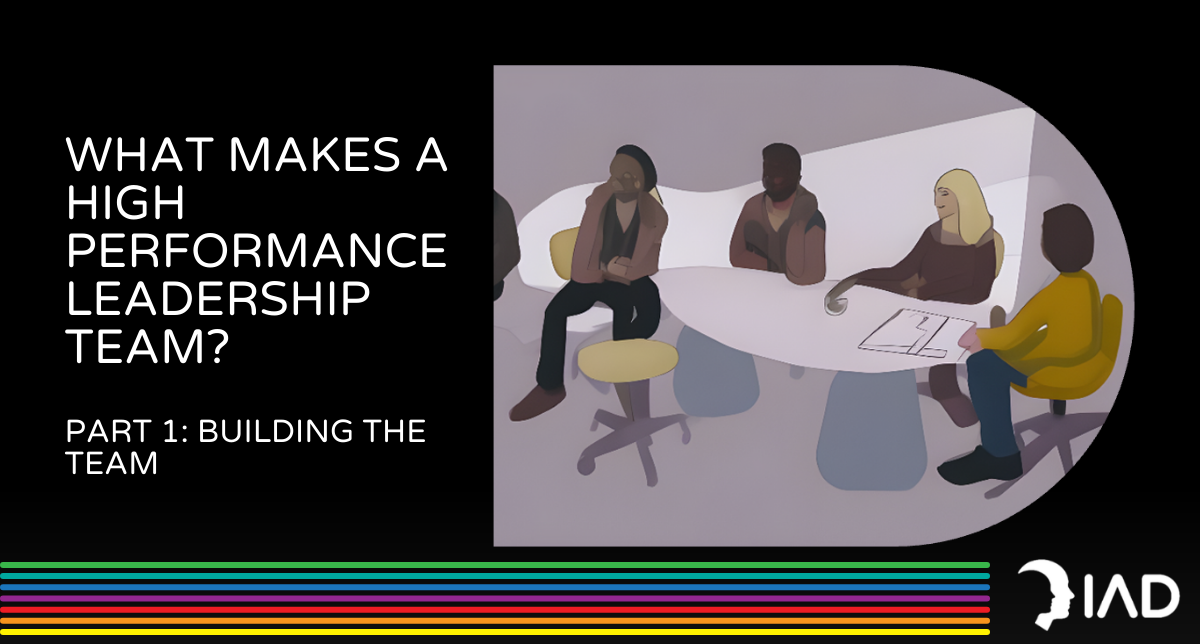What makes a high performing leadership team? Pt1
Part 1: Building the team

It’s tempting to think that just because your team is made up of the company's leaders that somehow it’s immune from the difficulties that other teams have.
We were reminded of the fallacy of this assumption in a recent conversation with the founder of a rapidly growing company when he expressed concerns about how well his leadership team were ‘playing’ together.
A quick search for ‘what makes a high performing team’ will reveal a number of different models containing varying numbers of characteristics of ‘high performing teams’
A further quick search on AnswerThePublic for ‘leadership team performance’ will also reveal that you are not alone in being cognitively biassed ‘Toward’ an outcome - there are no questions about solving (moving ‘Away From’) poor leadership team performance!
And therein lies the problem. Not this specific cognitive bias, but cognitive biases in general.
Or at least those biases that are germane to leadership, which is most of them!
But before we even get to ‘leadership’ we need to address ‘team’.
A simple, but useful, definition is that a team is a group of people who share a common goal or goals; the members have individual and/or mutual accountabilities, but, importantly, they succeed or fail collectively, not individually.
Members of a team therefore:
- should be perspectively adroit, being able to recognise the needs that serve the bigger picture
- should have a flexible working style, being able to embrace team or individual work as required, and they
- should have sufficient trust in the team and the organisation which it serves to truly ‘buy into’ the collective nature of their success or failure, whilst maintaining a level of scepticism that allows them to be effective in their role.
Of course, there’s a lot more to even a basic definition of teamwork than this.
However even with these as prerequisites, only a small percentage of people are cognitively unbiased enough to meet these limited criteria, never mind the broader cognitive needs of functioning at the level required for a high performance leadership team.
This is where we come to the second problem.
Most team development approaches focus on (a) the characteristics of a team (the content), and (b) the dynamics between team members that support those characteristics (the processes).
Both, of course, are important.
And when we understand that the dynamics between members precede the characteristics, we also understand that the dynamics are preeminent.
Dynamics between individuals, however, are symptoms of their construction of self and others - their cognitive biases.
So we can recognise that at the root of team performance are the cognitive biases of the individual members.
Targeting the dynamics themselves is akin to treating stress related indigestion with antacids; at best it might treat the symptoms for a while, but only at the expense of ongoing ‘treatment’ and longer term health.
Rather, we must target the construction of the individuals at the level of their cognitive biases to influence the dynamics, and thus the characteristics.
How can this be done?
In the first instance, we have to know what the cognitive biases of each individual are.
At the IAD we use the Identify Compass™ to deconstruct thinking styles across 50 dimensions (Cognitive Intentions) which enables us to discern cognitive biases at an individual level, and aggregate them up to the level of the team.
This tool also allows us to determine the individual’s developmental level which informs the appropriate developmental approach, and also ensures that they are partnered with an appropriate developmentalist.
Next we need to understand the current state of the team dynamics.
Again, the Identity Compass™ can provide us with this via its Job Motivation scoring.
However, there are a number of tools available, many of them free, that can provide an assessment.
The information obtained from the thinking style deconstruction and team dynamics assessment enables prioritisation of focus for individual and team development.
From an individual development perspective, prioritising those individuals at the lowest developmental levels will benefit the team the most since this will raise the operational developmental level of the whole team.
Individual development should be initially focussed on those cognitive biases which have the biggest impact on teamwork, starting with those referenced above: Perspective, Working Style, and Convincer Strategy (trustful vs sceptic).
From a team development perspective, development might consist of different exercises focussed on those characteristics that are most in need of enhancement.
Sessions should be facilitated from two viewpoints:
- the content of the session, focussed on the selected characteristic (purpose, relationships, etc.)
- the thinking processes used in the discussion with a view to raising awareness of cognitive biases at play
To summarise then:
- Before a group of leaders can become a high-performing leadership team, they first have to become a team
- Cognitive biases are at the heart of team development
- Developing a team by targeting cognitive biases involves:
- Deconstructing the thinking styles of the individuals to discern their cognitive biases (unconscious intentions)
- Assessing team dynamics
- Using this understanding to prioritise individual and team development priorities
- Facilitating team development activities from the two perspectives of content and thinking processes
In Part 2 of What makes a high performance leadership team? We will explore some of the specifics involved in increasing the performance of the leadership team once it is operating as a team.
All Rights Reserved | Adult Development (UK) Ltd




